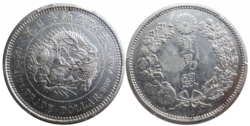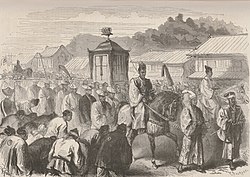Emperor Meiji
Mutsuhito or Emperor Meiji (Japanese ; 明治天皇, Meiji-tennō, 3 November 1852–30 July 1912) was the 122nd emperor of Japan according to the traditional order of succession.[1] His reign lasted from 1867 until his death in 1912.[2] He was Emperor of the Empire of Japan from 1867 to 1912 and he was the leader of Japan in the First Sino-Japanese War (1894–1895), the Boxer Rebellion (1899–1901) and the Russo-Japanese War (1904–1905), being rivals with the Qing dynasty, the Russian Empire and European Powers. He was involved in the Boxer Rebellion to stop Qing Empress Dowager Cixi. Emperor Meiji allied with Russia (led by Nicholas II), Germany (led by Kaiser Wilhelm II), Austria-Hungary (led by Franz Joseph I of Austria), France (led by Félix Faure and Émile Loubet), Britain (led by Robert Gascoyne-Cecil, 3rd Marquess of Salisbury) and the United States of America (led by William McKinley) to help General Yuan Shikai in the Boxer Rebellion (1899–1901). He was also involved in the Philippine-American War (1899–1902) along with Emperor Wilhelm II before the Russo-Japanese War in 1904. He was Emperor of Japan (1867–1912), Taiwan (1895–1912) and Korea (1910–1912).
| Meiji | |
|---|---|
 Emperor Meiji in 1888 | |
| Emperor of Japan | |
| 3 February 1867–30 July 1912 (45 years, 178 days) | |
| Predecessor | Kōmei |
| Successor | Taishō |
| Born | Mutsuhito 3 November 1852 Kyoto, Empire Of Japan |
| Died | 30 July 1912 (aged 59) Tokyo,Empire Of Japan (Today ; Japan) |
| Burial | Mozu no Mimihara no naka no misasagi (Osaka) |
Events of Meiji's life
Meiji's reign was marked by many changes including the move of the Imperial court from Kyoto to Tokyo.
Timeline 1852-1912
A timeline of major events includes:
- 1852 (Kaei 5): A son called Sachinomiya is born to Emperor Kōmei
- 1860 (Ansei 7): Sachinomiya becomes official heir and his personal name (imina) becomes Mutsuhito.
- 1867 (Keiō 3): Kōmei dies and the responsibility of the throne passes to Crown Prince Mutsuhito.[3]
- 1868 (Meiji 1): Official beginning of the emperor's reign[2] and Japanese era name becomes the first year of Meiji.[4]
- 1869 (meiji 2): Marriage to Ichijo Haruko, who becomes Empress Shoken.[5]
- 1879 (meiji 12): Prince Yoshihito (the future Taisho Tenno) is born.[6]
- 1889 (Meiji 22): Meiji Constitution is proclaimed
- 1894 (Meiji 27): Sino-Japanese War
- 1899-1901 Boxer Rebellion
- 1904–1905 (Meiji 37-38):: Russo-Japanese War
- 1912 (Meiji 45): The emperor dies
After death
He died in Tokyo. A detailed account of the state funeral in the New York Times concluded with an observation: "The contrast between that which preceded the funeral car and that which followed it was striking indeed. Before it went old Japan; after it came new Japan."[7]
The spirits of Emperor Meiji and his wife are honored at the Meiji Shrine (明治神宮, Meiji Jingū) in Tokyo.[8]
Honors
- Order of the Garter, 1906[9]
Emperor Meiji Media
Silver coin: 1 Japanese Trade Dollar, Meiji 9 – 1876
The sixteen-year-old emperor, traveling from Kyoto to Tokyo at the end of 1868
First-ever photograph of Emperor Meiji at the Yokosuka Naval Arsenal by Baron Raimund von Stillfried on 1 January 1872
Related pages
References
- ↑ Imperial Household Agency (Kunaichō), 明治天皇 (122). Retrieved 2011-10-16.
- ↑ 2.0 2.1 Nussbaum, Louis-Frédéric et al. (2002). "Traditional order of Tennō" in Japan encyclopedia, pp. 962-963.
- ↑ Nussbaum, "Kōmei Tennō" at p. 553.
- ↑ Nussbaum, "Meiji" at p. 624.
- ↑ Nussbaum, "Meiji Tennō" at p. 624.
- ↑ Nussbaum, "Taishō Tennō" at p. 929.
- ↑ "The Funeral Ceremonies of Meiji Tenno" reprinted from the Japan Advertiser [Article 8—No Title], The New York Times. 13 October 1912. Retrieved 2011-10-16.
- ↑ Japan-guide.com, "Meiji Shrine"; Meiji jingū, "Introduction". Retrieved 2012-6-13.
- ↑ "The Mikado's Garter," The New York Times. 28 July 1906. Retrieved 2011-10-16.
Further reading
- Jansen, Marius. (1995). The Emergence of Meiji Japan. Cambridge: Cambridge University Press. ISBN 9780521482387; ISBN 9780521484053; OCLC 31515308
- Keene, Donald. (2002). Emperor of Japan: Meiji and His World, 1852–1912. New York: Columbia University Press. ISBN 9780231123402; OCLC 46731178
Other websites
![]() Media related to Emperor Meiji at Wikimedia Commons
Media related to Emperor Meiji at Wikimedia Commons
| Preceded by Emperor Kōmei |
Emperor of Japan Meiji 1867-1912 |
Succeeded by Emperor Taishō |










